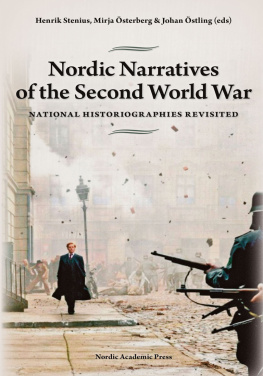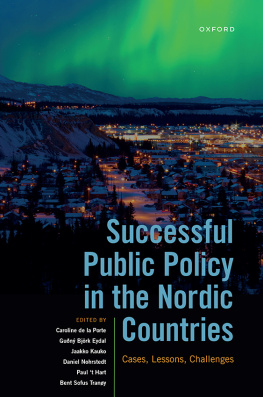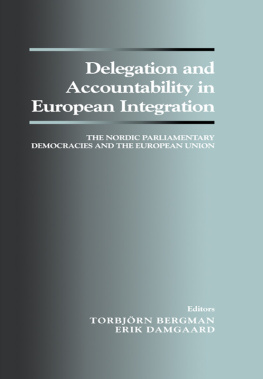Nordic Narratives of the Second World War
National Historiographies Revisited
Henrik Stenius, Mirja sterberg
&
Johan stling (eds.)

NORDIC ACADEMIC PRESS
Nordic Academic Press
P.O. Box 1206
SE-221 05 Lund, Sweden
www.nordicacademicpress.com
Nordic Academic Press and the authors 2011
Cover: Jacob Wiberg
Cover image: Scene from the Danish movie
Flammen & Citronen, 2008. Nimbus film/Tonny Madsen, Denmark.
Tryckt utgva ISBN 978-91-85509-49-2
E-bok ISBN 978-91-85509-80-5
Preface
The first step towards writing this book on the Nordic narratives of the Second World War was taken at a seminar hosted by the Norden Institute in Finland (Nifin) in Helsinki on 27 November 2007. The seminar, entitled Nordiska en-doktrinstater: nya och gamla analyser av de nordiska staterna under andra vrldskriget, was opened by Henrik Stenius at the Centre for Nordic Studies at University of Helsinki (CENS), that has been the driving force institution behind this book project. Presentations at the seminar were given by Henrik Meinander (University of Helsinki), Lars Mjset (University of Oslo), Uffe stergrd (Copenhagen Business School) and Johan stling (Lund University). At the next stage, the network was extended with Synne Corell (University of Oslo), Gumundur Hlfdanarson (University of Iceland) and Bo Strth (University of Helsinki). Mirja sterberg (CENS) was appointed coordinator of the network.
The Joint Committee for Nordic Research Council for the Humanities and the Social Sciences (NOS-HS), a research funding body under the Nordic Council of Ministers, has financially supported the network that put together this volume. Thanks to their funding, we were able to arrange two subsequent meetings, the first in Copenhagen and the second in Lund.
The making of this anthology has had an element of unpremeditation, space for intellectual creativity, questioning and revaluations. Contrasting national narratives and revisions of these interpretations with one another offered insights that forced the writers of this volume to react to new questions and new perspectives, and to think new thoughts.
On behalf of the whole network group, the editors would like to express their gratitude to Nifin, CENS, NOS-HS and Nordic Academic Press, and to Pirkko Hautamki, who helped us beyond measure by checking our English.
Helsinki and Lund
Henrik Stenius, Mirja sterberg & Johan stling
CHAPTER 1
Nordic Narratives of the Second World War
An Introduction
More than seventy years since the outbreak of the Second World War, the great catastrophe still rumbles on. Indeed, the battle over the meaning of the conflict rages, not least in Europe. In recent decades, the legacy of the war has sparked inflamed debates on how to interpret the past across the Continent. In France and Belgium, heated discussions about collaborators and resistance fighters broke out in the 1980s, and in Austria and Italy a tardy examination of the history of the war years slowly began. The end of the Cold War, moreover, brought forgotten memories and suppressed experiences back to life. In neutral countries, appeasement, foreign policy and financial relationships with Nazi Germany have been a recurrent theme of debate since the early 1990s. Also in many parts of Eastern and Central Europe from Kragujevac in Yugoslavia to Jedwabne in Poland the Second World War has entered the public discourse. What was common to all the debates was a pungent smell of hypocrisy, as if Europeans had been living with a misguided history of the war.
Today, at some distance from the most hot-tempered contentions of the war, a general pattern has emerged: the debates were all confrontations between old and new narratives of the Second World War. Although they had much in common, the controversies were at the same time shaped by national traditions and experiences. To grasp fully the character and dynamics of the transformation of these interpretations, it is necessary to focus on a limited number of national contexts.
In this book, these national contexts are comprised of the five Nordic states. While the political cultures in Denmark, Finland, Iceland, Norway and Sweden have their own important specificities, these countries developed a similar social and economic system in the course of the twentieth century. In terms of security policies and their trajectories of the Second World War, however, the Nordic states differ rather dramatically. Denmark and Norway were occupied by Germany, and Iceland by Britain and the United States. Many Finns suffered badly in 19391945 in repeated military operations first with the Soviet Union and then with German troops, whereas the Swedes, by contrast, were spared atrocities, desolation and loss of life. Not surprisingly, the Nordic countries have had differing canonised narratives of the Second World War, and the revisions of these patriotic narratives have differed accordingly.
Working on Nordic narratives of the Second World War, putting together the networks goals and outlines for this anthology, writing and disseminating the individual chapters, and last but not least, composing the introductory chapter, has been an interesting challenge with many twists and turns. New questions have arisen while we have attempted to put the war experiences in new perspectives. It has become clear that during the whole process there have been four distinctive tensions that the network has grappled with. The five national analyses of how the narratives of involvement in the Second World War have been fashioned and revised over time show that they all bring to the fore the following tensions:
Security policy doctrines. There is a tension between security policy doctrines and interpretations of the Nordic countries involvement in the war. It is obvious that history writing as a political activity has depended on the security arrangements the writer is living with.
Democratisation of foreign policy. Who has the right to take part in foreign policy debates and deliberations? To what extent have security policy issues been regarded as an exclusive policy area for the political elite, and to what extent are security arrangements an issue for the general public?
Moral turn. In what sense did the end of the Cold War cause changes leading to a moral turn in the way the Nordic countries involvement in the Second World War has been evaluated? Can one identify new moral dimensions in the interpretations compared with those prevailing during the Cold War? What has the role of the Holocaust been in the five Nordic countries?
Lack of Nordic similarities. One can question whether there are any signal similarities in the narratives of the Second World War in the five Nordic countries. Nordic citizens look upon the world in many important respects in a similar way, which could be called Nordic. But in the field of security arrangements views have been too divergent to amount to decisive common patterns. In the end, one could argue that if one wants to look for similarities, one had best focus on only three of the Nordic countries, that is, Denmark, Norway and Sweden, and conclude that these three countries have one fundamental experience in common: the trauma of not providing a forceful defence or indeed not contributing to the defeat of Nazism. Finland and Iceland have not been much haunted by such considerations.
This introduction will address these tensions by underlining that one can look at these issues from different perspectives, not by casting about for one single truth.
The Patriotic Narrative
The divergences between older and newer interpretations of the Second World War have developed into a specific and vital field of research. Of course, such studies differ in their empiric and theoretical approaches, but they share an interest in the Second World War as constituting the national self-understanding and historical consciousness in European countries throughout the post-war era.
Next page







